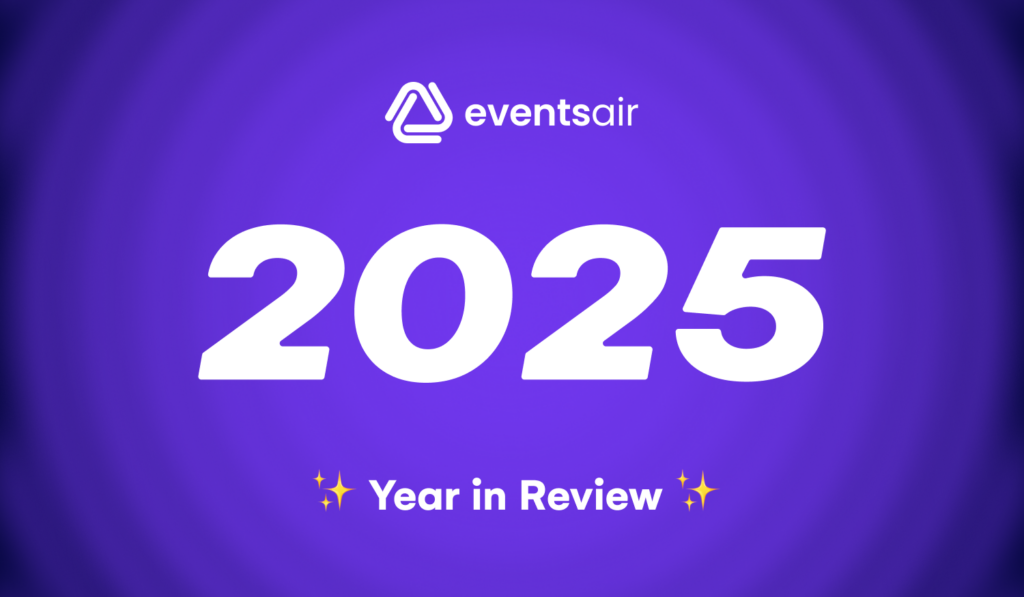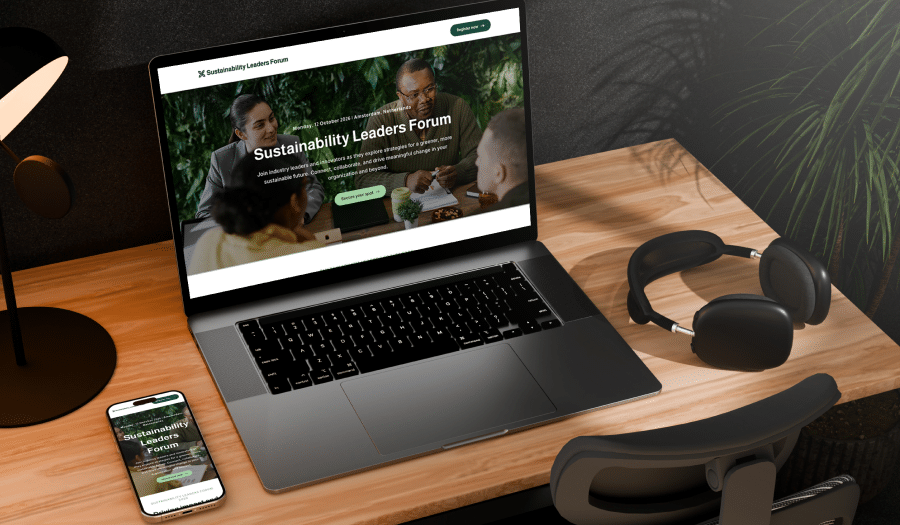
Over the years, virtual events have significantly improved from the era of low-quality webinars and frustrating buffering. Nowadays, cutting-edge technology such as ultra-low latency streaming services and professional-quality video content has made it possible to captivate online audiences and create engaging remote attendee event experiences in multiple ways.
You see, what sets a virtual event apart is its ability to offer an interactive and immersive experience that establishes a genuine connection between attendees, content, and other participants. This type of engagement helps to create a memorable and impactful event that goes beyond just information sharing.
When planning a virtual event, it’s important to think beyond the traditional single-speaker session and explore the potential of offering multiple live video presentations concurrently. By doing so, you can provide a range of shorter sessions that appeal directly to specific segments of your audience. This allows for more relevant and engaging sessions, and thanks to the power of virtual, attendees can always catch up on-demand if they miss out on any sessions.
This article will focus on tips and tricks for event planners looking to create virtual events that rival in-person conferences – let’s dive in.
Transcending the webinar and annihilating screen fatigue
With the right strategies in place, virtual events can transcend the monotony of webinars, eliminate screen fatigue, engage online audiences, and allow attendees to make meaningful connections in the virtual space.
Event planners often ask:
- How to ensure that attendees don’t feel disconnected from each other?
- You can incorporate icebreakers, team-building exercises, and virtual networking activities.
- What’s the best way to manage speakers and ensure that the event runs smoothly?
- Have clear communication channels, run rehearsals, and have a contingency plan in case of technical difficulties.
- How to monetize your virtual event and increase ROI?
- Offer sponsorships, paid access to exclusive content or experiences, and sell merchandise or products related to the event.
Developed in response to the Covid-19 pandemic, OnAIR offers a host of ways in which you can create highly appealing, engaging and memorable virtual events. We offer a solution that provides studio-like features to manage your speakers and engage your audience in interactive virtual events. With synchronized sessions, live streamed panel discussions, and on-demand sessions, we help ensure that your virtual event is a success and of course, profitable.
Tips to make virtual events more engaging
To create immersive and engaging virtual events, it’s important to move away from the traditional webinar format and incorporate interactive and personalized elements. In this article, we will examine several tips to consider when planning your next event:
- Include interactive content
- Add interactive components
- Boost engagement with gamification
- Utilize essential tools
- Stir things up with interactive sessions
- Use visual branding and messaging to engage
- Measure engagement with analytics and surveys
- Leverage pre-event promotion to increase attendance and engagement
- Use rapid-fire learning to keep your attendees engaged
- Ensure accessibility for all attendees
- Integrate offline experiences by sending branded gifts to attendees before the event and finding a way to incorporate them
By implementing these tips, you can create a virtual event that is both immersive and engaging, leaving a lasting impact on your attendees.
1. Include interactive content
To upgrade your virtual events and make them more engaging, start by providing high-quality video content and an ultra-low latency streaming service. This will allow you to ditch the grainy webinar feed and constant buffering, while also providing a more professional and engaging experience for your audience.
Another way to make your virtual events more engaging is by offering a range of shorter sessions that address niche topics directly related to your audience’s interests. This approach is more effective than offering a long single-speaker session covering a broad topic, as it allows you to cater to specific segments of your audience and make the sessions more relevant and engaging for them. By segmenting your content and tailoring it to specific interests, you can increase participation and overall engagement from your audience.
One of the great advantages of virtual events is that you can live stream multiple video presentations concurrently, providing more options to your audience. You can also use synchronized sessions to live stream pre-recorded presentations with speakers from other time zones and then bring in the presenter at the end of the session for a live Q&A, increasing engagement and participation.
Incorporating live-streamed panel discussions and video chat groups is another excellent way to encourage audience participation during your event. Additionally, offering on-demand video content during and after the event is an effective way to enable attendees to catch up on sessions they may have missed. You can even sell access to on-demand sessions after the event to non-attendees, increasing your ROI.
It’s important to remember that video quality is essential if you want to present a professional image for your brand and your event. It’s worth investing in a solution that offers studio-like features to manage your speakers, such as OnAIR. With high-quality video content and a top-notch streaming service, you can offer your audience a truly engaging virtual event experience.
2. Add interactive components
Incorporating interactive components into your virtual event can help you establish that elusive connection we all crave. While it may not compensate for the food and the chance to network in-person with others in your industry, it goes a long way in creating an enjoyable and engaging experience.
Adding a live host to your virtual event is an excellent way to ensure the event kicks off on a high note and that positive vibes continues throughout the event. Attendees are immediately welcomed by a real person in real-time as they enter the event, and the presence of a live host generates excitement, making attendees feel as if they were at an in-person event. You can also eliminate dead space during your event by bringing in the live host during breaks between sessions to make announcements, entertain guests with anecdotes, encourage participation in gamification, and update attendees on the scores or live poll results.
One of the most important and valued aspects of events is the opportunity to meet face-to-face with others. PCOs are often concerned that virtual events cannot provide this connection, but advances in technology have made it easy to meet face-to-face with speakers, sponsors, and fellow attendees at virtual events. OnAIR’s Meeting Hub and Networking group features go above and beyond the standard online meeting to provide an immersive networking experience.
Networking groups, similar to mixers at in-person events, allow groups of 4-10 people to take part in networking sessions. They spend a set amount of time getting to know each other before meeting allocations rotate, and new networking groups are formed. Those who wish to continue the discussion can schedule a video chat in the Meeting Hub. People from outside the event can also be invited into the Meeting Hub from anywhere around the globe to add value to the discussion.
Virtual exhibition booths are an excellent way to attract sponsors to your event and engage your audience. Exhibitors can set up fully branded virtual exhibition booths where attendees can book one-on-one meetings with the representatives to find out more about their products/services. Visitors in the virtual queue can download and browse through PDF brochures and watch sponsor videos. They can also attend other sessions and will be reminded when their meeting is about to start. The exhibitor can invite external guests from anywhere in the world to join these meetings and lend their expertise.
3. Boost engagement with gamification
Gamification is an excellent way to get attendees involved and invested in your virtual event. By incorporating game-like elements into your event, you can increase audience engagement, create a sense of friendly competition, and encourage attendees to interact with one another.
Consider including challenges, quizzes, or interactive polls throughout your event. You could even create a leaderboard that displays the scores of attendees who participate in the gamification. Prizes can also be offered to those who score the highest, providing extra motivation to engage with the event.
To further enhance engagement through gamification, you can consider designing custom games that align with your event’s theme or purpose. These games can be created specifically for your virtual event and can include elements such as scavenger hunts, puzzles, and virtual reality experiences. By creating custom games, you can offer attendees a unique and immersive experience that they won’t find elsewhere.
Another way to use gamification is by incorporating social media into your virtual event. Encourage attendees to share their experiences on social media platforms using a specific hashtag. You can then offer rewards or prizes to those who share the most, creating a sense of competition and encouraging attendees to engage with each other.
Furthermore, you can use gamification as a way to collect data and insights about your attendees. For instance, by using interactive polls and quizzes, you can gather information about their interests, preferences, and feedback. This data can then be used to tailor future events and improve the overall attendee experience.
Overall, gamification offers a fun and effective way to boost engagement and interaction in virtual events. Whether through pre-designed games or custom-made experiences, incorporating gamification elements can create a memorable and enjoyable experience for attendees.
4. Utilize essential tools
When planning a virtual event, it’s important to think about the different ways you can encourage attendees to interact with each other and the content. Live Q&As, discussion forums, live polling, and session surveys are great tools to facilitate engagement and gather feedback from attendees.
During live Q&As, attendees can submit questions to presenters in real-time, fostering engagement and providing an opportunity for attendees to have their questions answered. Discussion forums can also be used to create an ongoing conversation about the event, allowing attendees to share insights and connect with one another beyond the duration of the event.
Live polling is another effective way to engage attendees by allowing them to share their opinions and see how their views compare to others in real-time. Session surveys can be used to gather feedback from attendees on specific sessions, speakers, or the event overall, providing valuable insights for future event planning.
By utilizing these essential tools and encouraging attendees to interact with each other and the content, you can create a more engaging and interactive virtual event.
5. Stir things up with interactive sessions
Interactive sessions are hugely popular in virtual events, particularly with long agendas, as they break up the program and reduce screen fatigue. Consider getting creative with interactive sessions by sending out kits to attendees prior to the event with instructions not to open them until the session starts. The kits can then be unpacked and used during the interactive session.
Some examples of interactive sessions that virtual attendees have loved include live wellness breaks, coffee-making, cocktail-making, and wine tasting sessions. These sessions add a personal touch to the event and create a more memorable experience for attendees. We have been bowled over by the creativity of event planners when it comes to using OnAIR to create interactive sessions.
The EventsAir OnAIR solution was a great way for attendees to interact with speakers through one sole portal. It was all integrated into the one space.
Michael Kollmorgen – Girls in Tech. Read case study.
6. Use visual branding and messaging to engage
Visual branding and messaging are key components of any successful virtual event. Your branding and messaging should be consistent and engaging, reflecting your company’s values.
Consider using custom graphics, animations, and videos to enhance the overall look and feel of your virtual event. A visually appealing event will capture attendees’ attention and make them more likely to engage with your content.
In addition to visual elements, physical branding is also important in virtual events. By including branded merchandise or products in event kits, you can physically place your brand into the hands of attendees and leave a lasting impression.
Furthermore, utilizing a completely customizable virtual event platform like OnAIR can maximize brand exposure during the event itself. This allows you to add your branding and messaging in various places, such as the event portal or virtual booth, to reinforce it to attendees.
Don’t forget to also encourage sponsors to get involved in your event by offering them opportunities to display their branding within the portal or virtual booth. This can not only benefit the sponsor, but also help enhance the overall branding and messaging of the event.
After the event, consider leaving the event portal open for a few days to allow attendees to revisit the event and provide further exposure for your brand. This can be a great opportunity to drive engagement with your brand and even generate new leads.
Remember, visual branding and messaging are not only important for the event itself, but also for the overall impression attendees have of your brand. By creating a consistent and engaging visual identity, you can leave a lasting and positive impression on attendees.
7. Measure engagement with analytics and surveys
Measuring attendee engagement is essential to improving future virtual events. Utilizing analytics and surveys can provide valuable insights into what worked well and what needs improvement.
One of the key benefits of virtual events is the ability to track and measure attendee engagement. Through analytics and surveys, event planners can gain insights into attendee behaviour and preferences, and use this data to make informed decisions about future events.
Analytics can help event planners track a variety of parameters, such as how many attendees visited each session, how long attendees stayed engaged, and which speakers generated the most interest.
In addition to qualitative feedback, surveys can also provide valuable feedback on attendee engagement. By asking attendees to rate the sessions, speakers, and overall experience, event planners can gain qualitative insights into what worked well and what needs improvement. This feedback can be used to make adjustments for future events and improve the attendee experience.
Both analytics and surveys can also provide valuable data on exhibitor engagement. By tracking metrics such as how many meetings were scheduled by each exhibitor and which brochures were most downloaded, event planners can gain insights into exhibitor performance and use this data to improve future events.
Overall, measuring attendee engagement through analytics and surveys is essential to creating successful virtual events. By using data to inform decision-making, event planners can continuously improve and create a more engaging experience for attendees.
8. Leverage pre-event promotion to increase attendance and engagement
Promotion is not just about getting people to attend your virtual event, but also about generating excitement and engagement. By using creative and engaging pre-event promotions, you can build anticipation and create a sense of community among your attendees before the event even begins.
Consider using social media platforms to create event pages and share teasers about the content and speakers. Share behind-the-scenes glimpses of the planning process, offer sneak peeks of the content or special offers and contests to encourage attendees to participate and engage with the event.
Creating a countdown to the event, offering exclusive early-bird discounts, or providing sneak peeks of the content can also generate excitement and encourage attendees to register. Additionally, consider sending personalized emails to your attendees with targeted messaging, tailored content and providing useful resources that can help them prepare for the event (see how EventsAir’s event registration and marketing tools can help you do both these things).
By leveraging pre-event promotions effectively, you can create a sense of excitement and anticipation that will translate into higher engagement and participation during the event itself.
9. Use rapid-fire learning to keep your attendees engaged.
To keep your attendees engaged during a virtual event, consider implementing rapid-fire learning. Instead of spending long periods of time discussing one topic, break it down into shorter segments of 10 minutes or less, followed by a Q&A session.
You can also bring in multiple speakers to talk about the same subject, with each speaker presenting for a few minutes before tagging the next one in. Conducting polls during each rapid-fire presentation can further increase engagement and keep your audience on their toes. Rapid-fire learning is a great way to prevent boredom and keep your attendees interested and involved throughout your virtual event.
In virtual events, keeping your attendees engaged and interested can be a challenge. One way to do this is by using rapid-fire learning techniques. These techniques involve breaking down topics into shorter segments, each lasting 10 minutes or less, followed by Q&A sessions, polls, or other interactive activities.
Here are some examples of rapid-fire learning techniques that you can incorporate in your virtual event:
- Lightning talks: Invite multiple speakers to give short, focused talks on different topics related to your event. Each speaker can have 5-10 minutes to present their ideas, followed by a quick Q&A session.
- Ignite talks: Ignite talks are similar to lightning talks but with a twist. Speakers have 5 minutes to present their topic, and each slide is on a timer, changing every 15 seconds. This format can be especially useful for keeping your attendees engaged and interested in the presentation.
- Fishbowl discussions: This format involves a panel of experts discussing a topic while a small group of attendees sits in the centre, listening in. After a set amount of time, the panellists rotate with the audience, allowing everyone to participate in the conversation.
- Speed networking: Speed networking is a fun way to engage your attendees and help them build connections with each other. Set up a series of short one-on-one meetings between attendees, each lasting 3-5 minutes. After the allotted time, attendees rotate to meet someone new.
- Interactive quizzes: Conducting interactive quizzes can be an effective way to engage your attendees and test their knowledge on a topic. Use a polling or quiz tool to create multiple-choice or open-ended questions, and give attendees a short amount of time to answer.
- Lightning round discussions: A lightning round discussion involves posing a question to the group and giving attendees 1-2 minutes each to share their thoughts. This format can be especially useful for brainstorming sessions or when you want to get a wide range of ideas from your attendees.
By using these rapid-fire learning techniques, you can prevent boredom and keep your attendees interested and involved throughout your virtual event. Choose the ones that work best for your audience and event goals and keep things lively and engaging!
10. Ensure accessibility for all attendees
Make your virtual event accessible for all attendees by providing closed captioning or transcripts for videos and live sessions. This will ensure that those with hearing impairments can fully participate in the event and not miss out on any important information. Additionally, consider providing ASL interpreters for live sessions to further accommodate those with hearing impairments.
Other accessibility considerations to keep in mind include providing descriptive alt text for images, making sure your virtual event platform is compatible with screen readers and other assistive technologies, and offering options for attendees to adjust font sizes and color contrast to meet their needs. By making your event accessible, you can create an inclusive environment that welcomes all attendees and enhances engagement.
Virtual events don’t have to be lacklustre. By following these tips, you can create virtual events that transcend the monotony of webinars, eliminate screen fatigue, engage online audiences, and allow attendees to make meaningful connections in the virtual space. It’s important to use an event management platform which supports the organizer in creating engaging virtual events. EventsAir’s OnAIR solution is a great option to consider when planning your next virtual event.
More than 600,000 virtual attendees have created and hosted highly successful virtual events, all on a single user-friendly interface. OnAIR has revolutionized virtual events, and the EventsAir team will continue to develop innovative new features to make the virtual and hybrid event experience even more sensational.
If you’re interested in real-world examples of how EventsAir have tackled complex challenges and achieved impressive results, be sure to check out these compelling case studies.
To find out how you can use OnAIR to create and run highly immersive virtual and hybrid events, please book a free personalized demo of the software today.
Attendee Engagement | Attendee Experience | Event Planning & Management | Event Technology & Apps | Hybrid Events | Virtual Events
See EventsAir in action
Discover why 12,000+ event professionals trust EventsAir to deliver effortless events, every time.




